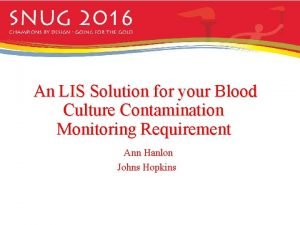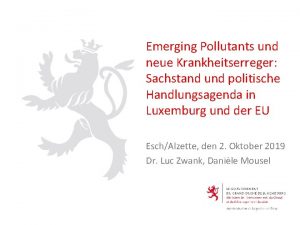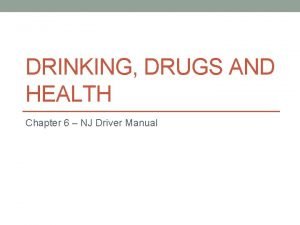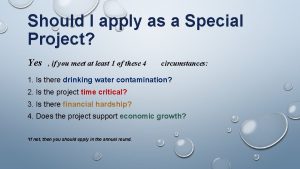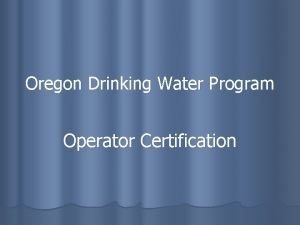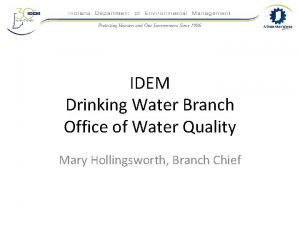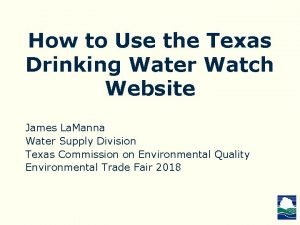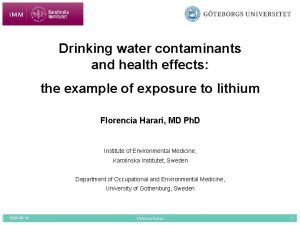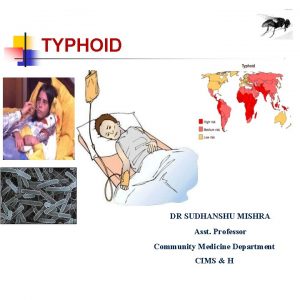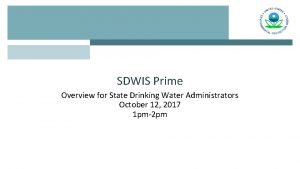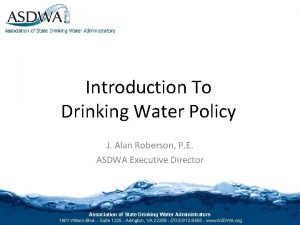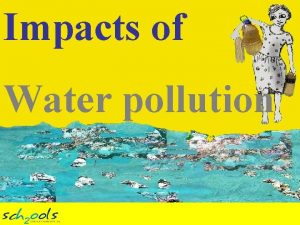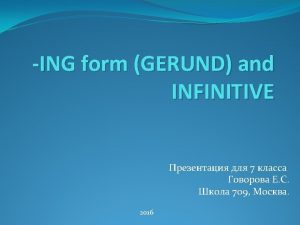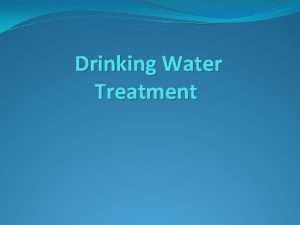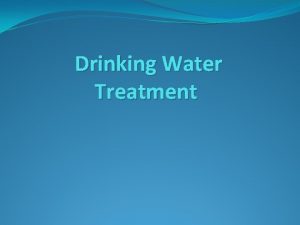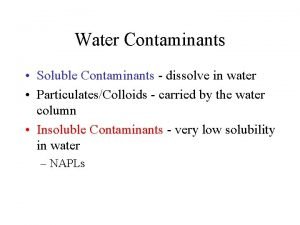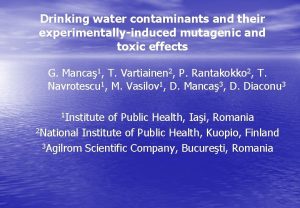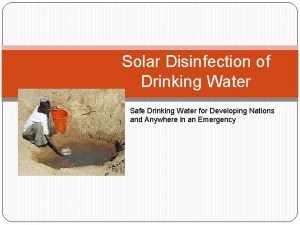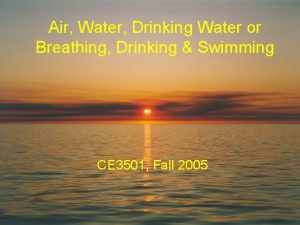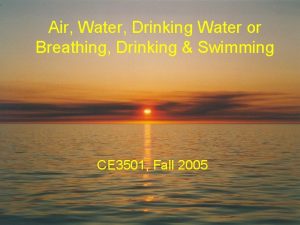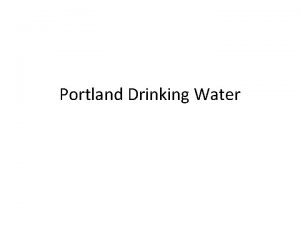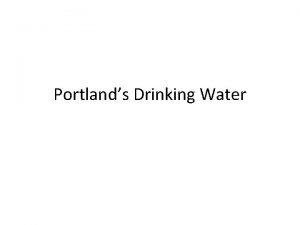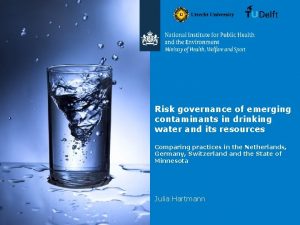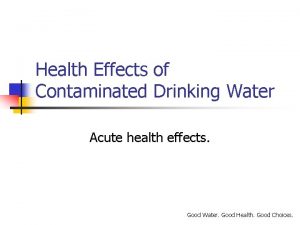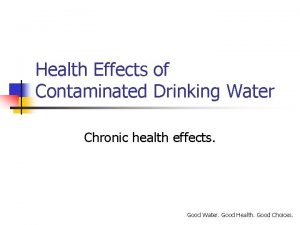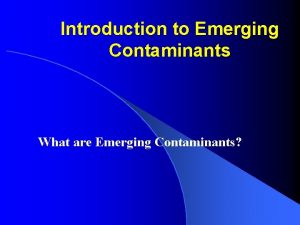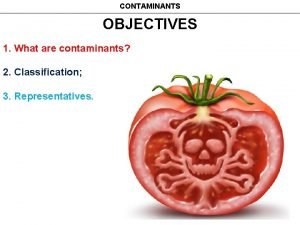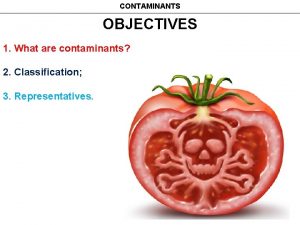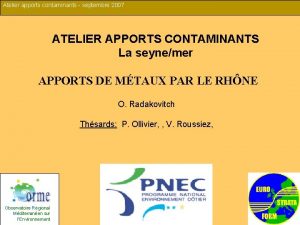Drinking water contaminants and health effects the example





















- Slides: 21

Drinking water contaminants and health effects: the example of exposure to lithium Florencia Harari, MD Ph. D Institute of Environmental Medicine, Karolinska Institutet, Sweden Department of Occupational and Environmental Medicine, University of Gothenburg, Sweden 2020 -09 -16 Florencia Harari 1

Drinking water contaminants: a public health problem § More than 2 billion people worldwide still don’t have access to safe drinking water sources. UN 2015 § Metals such as arsenic and lead are well-known water contaminants with reported health effects even at low levels of exposure. Moon et al 2017, Milton et al 2017, NTP 2012 § Less is known about other metals contaminating drinking water sources such as lithium. 2020 -09 -16 Florencia Harari 2

Lithium • Light non-essential metal. • Occurs naturally in rocks, soil and groundwater. • Increasing extraction and use worldwide. Uses of Lithium World lithium mine production (tonnes) Australia Chile China Argentina Zimbabwe Zimbawe U. S. A. Portugal Brazil Ceramics and glass 13000 Batteries 12900 21% 5000 29% Continuous casting 2% 4% 5% 2900 1000 12% 870 570 Lubricating greases Air treatment 27% Medicine Other uses 400 U. S. Geological Survey, 2012, 2015 2020 -09 -16 Florencia Harari 3

Lithium in drinking water: a problem? § Lithium may occur in drinking water at varying concentrations (1 -5, 000 µg/L). § Unknown how many people are exposed to lithium worldwide. § Guideline values only in Ukraine and Russia (30 µg/L). (Lithium therapy from ~300, 000 µg/dag) 2020 -09 -16 Florencia Harari 4

Lithium occurs also at highly varying concentrations (10 -10, 000 μg/L) in bottled water. And even historically…. . 2020 -09 -16 Florencia Harari 5

Lithium is used to treat bipolar disease: Li Li Li § The main adverse effects are: § Kidney impairment and polyuria. Li Li Li i L Li Li Li § Hypothyroidism and goiter. § Hyperparathyroidism § Adverse effects during pregnancy are: § Malformations § Fetal hypothyroidism and goiter § Prematurity Grandjean et al, 2013 2020 -09 -16 Florencia Harari 6

Aim: to investigate the association between environmental lithium exposure with maternal and infant health. Drinking water*: Lithium: 5 - 850 µg/L Boron: 300 - 7, 000 µg/L Arsenic: 1 - 250 µg/L Cesium: 1 - 400 µg/L *Vahter et al 1995, Concha et al. 2010, Harari 2015, Igra et al. 2016 2020 -09 -16 Florencia Harari 7

Study area ~8, 000 inhabitants Mostly indigenous 3, 200 -4, 000 masl Sparsely populated ~200 births/year 2020 -09 -16 Florencia Harari 8

Pilot study (n=10 pregnant women) The lithium concentrations in the first urine in life were about half of those in maternal urine. rs=0. 82 Lithium in maternal blood (µg/L) Lithium in infant urine (µg/L) Lithium in cord blood (µg/L) High correlation between maternal and cord blood First day of birth 2 -4 weeks 2 -4 months 4 -6 months Harari et al. Rep Tox. 2012 Thus, lithium crosses the placenta. 2020 -09 -16 Florencia Harari 9

Mother-child cohort in Argentina (N=194; 88% participation rate) October 2012 to December 2013 Non-smokers Blood, urine, water, ultrasound, anthropometry, questionnaire. 1 st Pregnancy trimesters 2 nd No alcohol 43% coca chewing. Age 13 to 41 years 3 rd Birth 3 months 6 months Infant age Cord blood, placenta, anthropometry. 2020 -09 -16 Florencia Harari Urine, breast milk, anthropometry, questionnaire Blood, urine, mouth cells, anthropometry, questionnaire 10

Lithium in drinking water and maternal health: § Lithium exposure from drinking water during pregnancy has been associated with: impaired maternal thyroid function (higher TSH and lower f. T 3 and T 3). Harari et al. Thyroid. 2015. TSH 2020 -09 -16 f. T 3 Florencia Harari 11

Lithium in drinking water and maternal health (cont). : § Lithium exposure from drinking water during pregnancy has been associated with: altered maternal calcium homeostasis (a 5 -times increased risk of vitamin D 3 deficiency). Harari et al. Env Res. 2016 -6. 1 nmol/L (95%CI -9. 5; -2. 6) for a 25 μg/L increase in blood lithium. 2020 -09 -16 Florencia Harari 12

Lithium in drinking water and infant health: § Lithium exposure during pregnancy was associated with impaired fetal size: newborns of mothers in the highest tertile of exposure were 0. 8 cm shorter compared to those in the lowest tertile. Harari et al. Env Int. 2015 2020 -09 -16 Florencia Harari 13

Lithium in drinking water and infant health: Inverse associations between infant urinary lithium (0 -3 m) and f. T 3 and T 3 Borderline inverse associations between cord blood lithium and f. T 3 and T 3. Models adjusted for age, U-iodine and selenium, infant sex, excl. breastfeeding. *Change per 10 μg/L increase in maternal or cord blood lithium. **Change per 50 μg/L increase in infant urinary lithium. 2020 -09 -16 Florencia Harari 14

General conclusions § Elevated exposure to lithium through drinking water during pregnancy may adversely affect prenatal development, possibly through disruption of the thyroid and calcium systems. § Lithium seems to have endocrine disruption properties. § If confirmed in other and larger studies, the findings have implications for the public health. § Reinforce the need for thorough screening of lithium concentrations in drinking and bottled water and further evaluation of the health effects. 2020 -09 -16 Florencia Harari 15

2020 -09 -16 Florencia Harari 16

Consequences of the findings: § Attacks from a company commercializing lithium-containing bottled water to stop the dissemination of results and to ask for removal of the articles in the newspapers. § Ministry of Health in Salta, Argentina and local municipality: § Have received continuous reports of the results. § We have measured lithium and other metals in alternative water sources. § Swedish Food Agency: § Review of the available data on lithium in drinking water. § Safe/harmful level? Benefitial level? 2020 -09 -16 Florencia Harari 17

THANK YOU! Acknowledgments § Participating mothers and infants § Hospital Dr. Nicolás Cayetano Pagano, San Antonio de los Cobres, Argentina § Institute of Environmental Medicine, Karolinska Institutet, Sweden § Unit of Metals and Health, Nutritional Epidemiology, and Biostatistics § Esperanza Casimiro § Marie Vahter § Graciela Colque § Agneta Åkesson § Alicia Soriano § Karin Broberg § Luis Lima § Brita Palm § Wilfredo Medrano § Margaretha Grandér § Primary health care workers § Helena Nordqvist § Ying Lu § Ministry of Health in Salta, Argentina § § Barbro Nermell Alberto Gentile § Matteo Bottai § University of Salta, Argentina § § Margareta Langeén Analía Boemo § Anna Karin Bernhardsson § INTA institute, Chile § Ana María Ronco § Miguel Llanos § Francisca Castro § National Food Agency, Sweden § Gabriela Concha § Funding agencies: 2020 -09 -16 Florencia Harari 18

Thank you! Florencia. Harari@amm. gu. se 2020 -09 -16 Florencia Harari 19


Thank you! Florencia. Harari@amm. gu. se
 Water and water and water water
Water and water and water water Common blood culture contaminants
Common blood culture contaminants Grundwasserreinigung emerging contaminants
Grundwasserreinigung emerging contaminants Good host law nj
Good host law nj Texas drinking water watch
Texas drinking water watch Drinking water state revolving fund
Drinking water state revolving fund Oregon drinking water program
Oregon drinking water program Indiana drinking water watch
Indiana drinking water watch Texas drinking water watch website
Texas drinking water watch website Lithium in drinking water
Lithium in drinking water Drinking water
Drinking water Drinking water system operator certificate
Drinking water system operator certificate Prime drinking water
Prime drinking water Nm drinking water watch
Nm drinking water watch Definition of pollution in simple words
Definition of pollution in simple words Effects of water pollution
Effects of water pollution What are 5 effects of water pollution?
What are 5 effects of water pollution? 8 effects of water pollution
8 effects of water pollution Youtube youtube
Youtube youtube Bmw drinking and driving ad
Bmw drinking and driving ad Solution for drinking and driving
Solution for drinking and driving Drink gerund or infinitive
Drink gerund or infinitive

